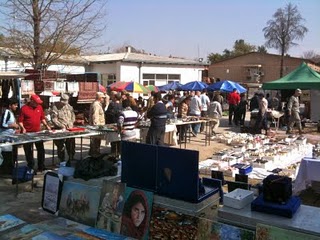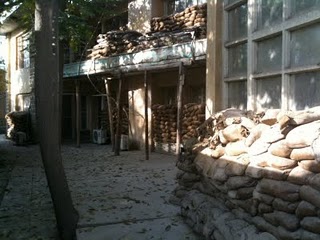It's getting darker earlier now that we're approaching Winter Solstice so I haven't taken more photos of the new place, The Tillman House, where I now reside. I work between 10 and 12 hours a day, so I arrive at work in the dark and leave to go home in the dark. On my recent "day off", where I only work 8 hours, I was able to get back to the abode and take some photos with my iPhone.
Portal shot of the Tillman House. One of the guards is walking towards me. The vertical electrical box to the right converts the generator power to 220 volts for the house electrical service.
Every house in Kabul has stone or concrete walls that separate it from the street and the neighbors. Every large home becomes a compound with a walled courtyard in the front with no backyard at all. Added to these walls now are additional blast walls and concertina that reminds us that we're living in a war zone. Rockets and mortars still fall within the compound and this additional protection is meant to keep you alive during these brief but intense reminders of war.
A shot taken from my room out to the courtyard.
The rose garden in our courtyard.
So, you're thinking that I'm living in the lap of luxury, right? Well, considering the tent I was in for the first two weeks, yeah, maybe I am. Despite the nice looking exterior to these newer buildings and houses, there really is no engineering underlying the construction. Our guy who manages the housing for my company told me that he supervised the construction of the Tillman House from day one. He said that the workers used practically no mortar when they set the bricks, used no rebar, and slapped concrete up quickly to finish the product. This area is prone to damaging earthquakes, and I was told to run out of the house should there be one -- this house probably would collapse.
When we first moved in, all the guys using the showers and toilets caused the sewer system to back up and flood throughout the first floor and basement of the house. KBR (the current support contractor) had to come out two days in a row to roto-root the drainage system to clear out all of the water bottles and plastic wrappings the construction workers had rammed down the drain.
In the photo above, you'll notice the yellow tank behind the rose garden. This is a chlorine injection system that squirts chlorine into the well water to kill some of the impurities. It doesn't kill all the bad stuff, so we still have to brush our teeth with bottled water. Anyway, this is our second tank. The first one died last week, in the process dumping the tank's entire chlorine contents into the well water. The next morning when we all rose to take showers and get ready for work, all that came out of the faucets and shower heads was milky white chlorine solution that reeked of its bleach smell. The chlorine ate away all the fake chrome plating from the sink and shower drains.
I made the right decision not to take a shower that day and poured a bottle of water over my head to sponge bathe. Others, not so wise, chose to risk a shower, and in the process one guy nearly was overcome by fumes and had to be dragged outside to recover. Others pissed into the toilets, mixing the ammonia in their urine with the chlorine, and creating mustard gas. Two other guys currently are suffering complications from this experience.
The street from the Tillman House leading outside the compound.
This photo depicts the street separating the US Embassy from the Tillman House. There's two blast walls adorned with concertina wire. The shorter one on the inside keeps us from escaping our man-made prison. The larger one prevents even the most persistent escapee from entering the US Embassy. Walking or driving from here to the outer gate entails passing through four other checkpoints all of which are protected by armed guards.
There's enough armed guards carrying AK-47s in our housing areas to maintain a certain level of safety. Nearly everyone else is armed too with M-4s and pistols. It's an armed camp that the Taliban can't easily penetrate. So, the rockets and mortars come instead.
All of this makes me appreciate raking leaves back home. At least there, I can drink beer.

























